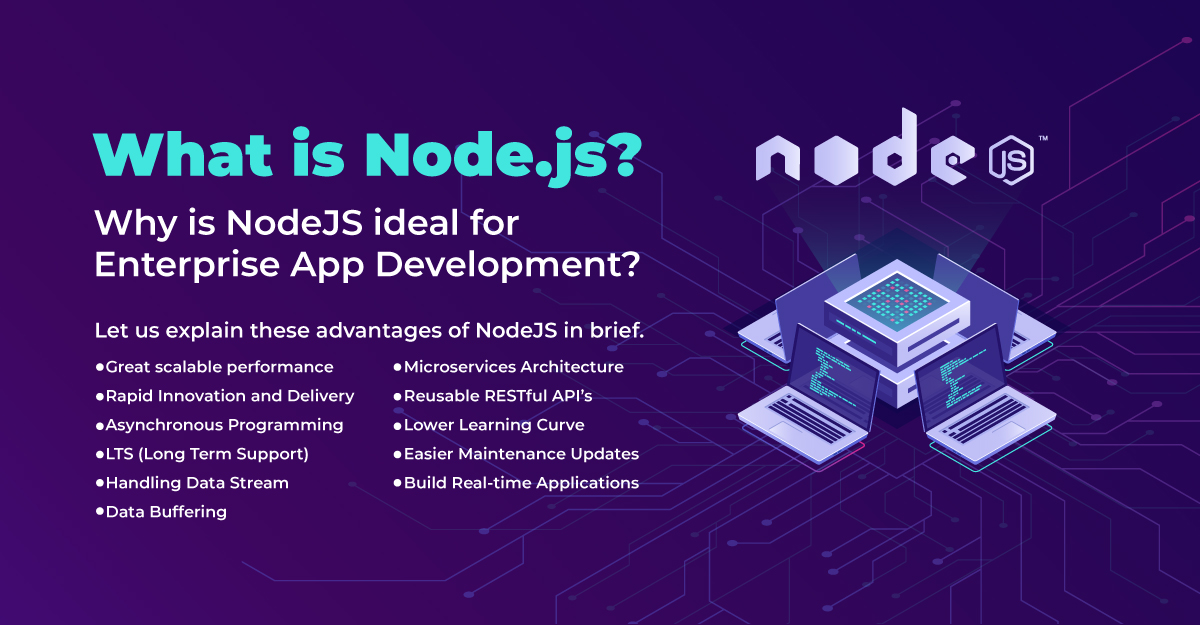The digital presence that an app might have is a vital component of a successful enterprise. Most enterprises require two aspects to fulfil the criteria of a digital presence: an app and a website. The development of an app involves the utilization of a computer language to create an intuitive interface. The usual language that is employed is Javascript. However, with the use of Javascript comes the requirement of NodeJS.
What is NodeJS?
The basis of enterprise app development services involves the use of a language, Javascript, in this case. Javascript is restricted by certain rules. One can think of it as grammar in the English language. The grammar in this scenario is NodeJS, a framework. The purpose of a framework is to house the javascript instructions in a way that is understandable to a server.
NodeJS is a cross-platform network and open-source software. It plays an important role in altering a dynamic webpage.
How is NodeJS a Beneficial App Development Language?
The concept of a dynamic webpage includes the ability of a visitor to interact with the web application or, in this case, the mobile app. A good and captivating app is usually one that is interactive. The use of NodeJS not only allows one to accomplish this but also offers an unprecedented amount of convenience while doing so. This is due to the flexibility and compatibility that it possesses. This is why enterprise app development services widely use NodeJS.
Benefits of Using NodeJS (in brief)
Unprecedented Performance:
NodeJS can incorporate languages like C++ to create the basis for the working of operating systems. It runs one command at a time (Single-threaded) and can prevent hindrances in the performance of the program.
Rapid Innovation and Delivery:
The programs that are instructed to run in the framework do so rapidly. This speed is especially seen with the use of javascript.
Asynchronous Programming:
This type of programming allows one to run programs independent of the main program. Therefore, one can test out features without disrupting the main program.
LTS (Long Term Support):
NodeJS can support and maintain release lines. These release lines are pathways or mediums through which one can carry out fixes and alterations to the app.
Handling Data Stream:
Streams allow one to write and perform an end-to-end transfer of information. From the various types of streams, the data stream is the most used. NodeJS handles data in this way.
Data Buffering:
Buffers are a component of NodeJS that allows the framework to store integers in the form of an array in the program.
Microservices Architecture:
App development for an enterprise is usually handled by a team. This involves relaying information between several devices. This process can lead to a decrease in the computing power of the program and an increase in RAM usage.
Reusable RESTful API’s:
This feature allows one to reuse an application to carry out operations without creating a new one from scratch.
Easy to Learn:
NodeJS and the use of Javascript forms the basis of app development. It is easy to master, as well.
Easy to Maintain:
The performance and speed of the framework are easy to maintain as the framework undergoes frequent updates.
Build Real-time Applications:
The NodeJS framework also provides real-time rendering options to developers.
An enterprise mobile application development company employs the use of NodeJS due to its ease of use and maintenance and the flexibility it offers to developers. NodeJS can increase productivity rapidly. With the ability to carry out quick and asynchronous programming, one can create intuitive apps using this framework. It is a great option to use when working as a team.




